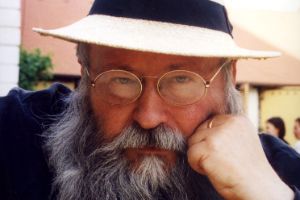Lecture
Hermann Nitsch
The Theatre of Orgies and Mysteries
Introduction: Peter Raue

Hermann Nitsch © Wobrazek
Lecture of the action artist
Hermann Nitsch could be called a personification of a different, virulent tradition of art and theatre history. Inspired by de Sade, Antonin Artaud, Sigmund Freud, Friedrich Nietzsche and others, he is concerned with a kind of art that oversteps all boundaries, that is ecstasy – an archaic and provocative artistic celebration of life. He is someone who defies the enclosures of that well-defined and manageable area called the art business and, alongside Schwarzkogler and Mühl, was co-founder of the “Wiener Aktionismus”. His “actions” can be described as an amalgamation of happening and religious ritual and frequently encompass interventions and incursions of art in various other realms: society, religion, politics – in all areas of life. Owing to the employment of sacrificial rituals and liturgical elements in his “Orgies and Mysteries” plays, he has had some ardent admirers and many spiteful enemies from the beginning: politicians, self-proclaimed defenders of public morals, animal activists and theologians have repeatedly raised protests and tried to outlaw him and the people around him in the eyes of the public. In 1971 he bought Prinzendorf castle in lower Austria with the intention to make it the centre for his O.M. Theatre – a venture that stands as a counter project to the Wagnerian concept of a “complete synthesis of the arts” and which Nitsch has always seen as the central project of his life’s work. The castle is where he celebrates with colleagues and friends and stages his big “actions” from time to time. With his “122. Aktion” at the Wiener Burgtheather Hermann Nitsch made it to the sacred hall of fame of the art and theatre world. Also Nitsch’s contribution to Berliner Lektionen will be dedicated to the O.M. Theatre and staged at Martin-Gropius-Bau in the frame of a major retrospective made possible by the friends of Neue Nationalgalerie.